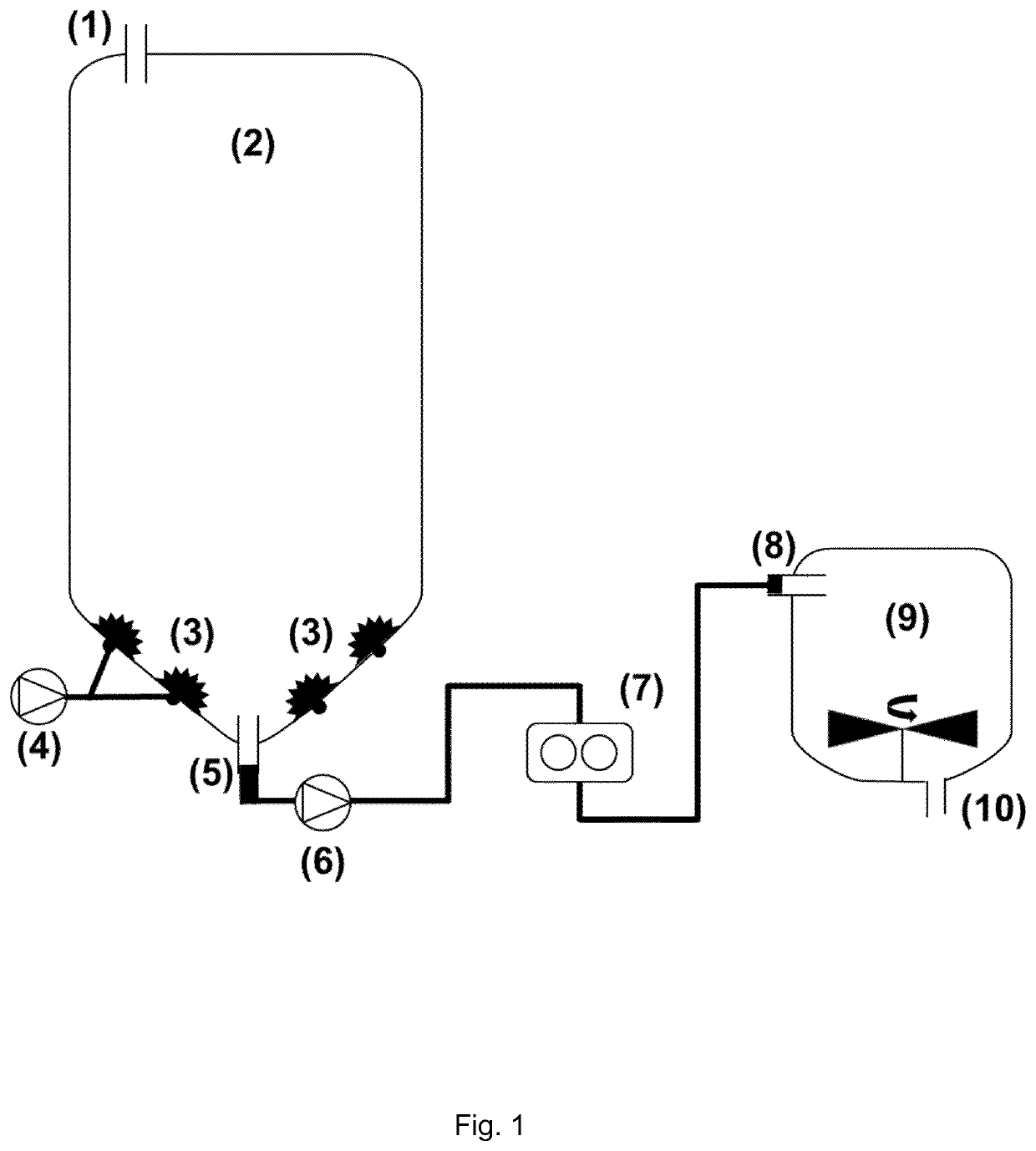Method for producing an extract of cereal and method for processing this extract into beverage
a technology of extract and cereal, which is applied in the field of germination and preparation of aqueous extracts of cereals, can solve the problems of difficult brewing process, increased potential for strecker aldehyde formation, and high levels of released soluble protein, so as to speed up the process of preparing wort and maintain the potential for preparing said wort. , the effect of fast germination
- Summary
- Abstract
- Description
- Claims
- Application Information
AI Technical Summary
Benefits of technology
Problems solved by technology
Method used
Image
Examples
example 1
ethod for Steeping and Germination
[0399]Dry barley grain was placed in an aqueous solution in a Plexiglass cylinder and constantly aerated with atmospheric air from beneath the column of grain. A schematic drawing of the equipment used is provided herein in FIGS. 1 and 2. Airflow was set using a SmartTrak® 50 mass flow meter and controller (Sierra, Calif., USA) and temperature was measured using a Testo 735 precision thermometer (Testo, Germany).
[0400]Sensors for measuring airflow, temperature, pH, conductivity, redox potential and O2 content of the steeping water were incorporated in this system. The sensors allow not only the process to be monitored in real time, but also to adjust steeping and germination conditions during the processes; this level of control is not possible by following current malting and brewing protocols.
[0401]GA is a phytohormone that activates the aleurone layer in germinating barley. Many maltsters add GA at low concentration during the malting process. He...
example 2
or Determining Enzyme Activity
[0405]During germination, the barley grain begins to secrete a range of hydrolytic enzymes, such as α-amylases, limit dextrinases and (1,3;1,4)-β-glucanases. Typically, these enzyme activities are detected in a timely coordinated manner, with the activities of α-amylase, β-amylase and / or limit dextrinase useful as general markers for activity of hydrolytic enzymes. Thus, the activities of α-amylase and limit dextrinase were monitored by measuring hydrolytic enzyme activities in grain and determined after germination performed according to the method of the invention.
[0406]Prior to enzyme activity analysis the germinated grain samples were milled using a standard Foss Cyclotech mill (Foss, Denmark), equipped with a tungsten carbide grinding ring (Foss 10004463), nickel plated impeller (Foss 1000 2666) and a 1 mm outlet screen (Foss 10001989). All measurements of enzyme activity in germinated barley grains were made within 48 h after mil...
example 3
elopment During Steeping and Germination Procedure
[0410]Hull-less barley line and hulled barley lines were incubated in a Plexiglass cylinder according to the general procedure described in example 1. The incubation procedure was performed at at 15° C. and 25° C. The grains were aerated from beneath with varying levels of atmospheric air for different time period, during which the grain moisture content raised and germination is initiated. The grain development was analysed after 24 h and 48 h of incubation and the water uptake in grains was asserted by determining the water content as % (w / w).
[0411]In detail, Grains of the a hull-less barley line were transferred to the Plexiglas cylinder and incubated using the WA regime. The grains were first incubated for 3 h in 1% P3-hypochloran (Ecolab, Switzerland) following incubation for 45 h in water adjusted to 1000 nM gibberellic acid (GA) and 0.01% Foamazol FCD511 (AB Vickers, Burton on Trent, UK). Incubation was at either 15 or 25° C.,...
PUM
 Login to View More
Login to View More Abstract
Description
Claims
Application Information
 Login to View More
Login to View More - R&D
- Intellectual Property
- Life Sciences
- Materials
- Tech Scout
- Unparalleled Data Quality
- Higher Quality Content
- 60% Fewer Hallucinations
Browse by: Latest US Patents, China's latest patents, Technical Efficacy Thesaurus, Application Domain, Technology Topic, Popular Technical Reports.
© 2025 PatSnap. All rights reserved.Legal|Privacy policy|Modern Slavery Act Transparency Statement|Sitemap|About US| Contact US: help@patsnap.com



